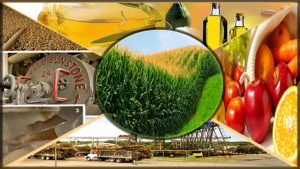Soil Organic Matter and role of nutrients
Wasim Javed and Najam abbas
Organic matter (O.M) consists of partially decayed and partially re-synthesized plant and animal residues. It also contains living and dead microbial cells, microbially synthesized compounds as a result of microbial activity.
Function of O.M.
- O.M is main source if different nutrients, Upon decomposition in soil, all plants animals residues release N,P,S and other nutrients essential for plant growth.
- It improves physical and chemical properties and structure of soil.
- It improves water holding capacity of soil organic matter can held water 20 times of its weight.
- It improves aeration and infiltration of soil. It gives dash color to soil and regulate the temperature.
- It increases the carton exchange capacity (CEC) of soil and soil retains nutrients against reaching.
- O.M helps in the aggregation of soil particles and structure of soil improved.
- It is used for the reclamation of saline/saline sodic soils.
- It is only source of organic carbon in soil so provides energy for microbes.
- O.M. buffer soil ph in the slightly acid neutral and alkaline ranges.
- Environmental point of view, O.M helps in degradation of pesticides, petroleum, cyc, heavy metals pollutants. It retains pollutants against reaching and retard pollution of ground water.
- It provides natural chelates which increased micronutrients availability.
Functions of Nutrients in Plants.
Macronutrients.
For proper plant growth , it need 16 nutrients that include carbon, hydrogen , oxygen, that plant acquire from air, calcium , magnesium and sulpher are considered as secondary element other can be divided into Macronutrient , that plant need in higher amount and micronutrient those are required in less
amount.
- NITROGEN.
1.. N is a constituents of all proteins and enzymes, several metabolic intermediates in synthesis and energy transfer and of DNA.
2. Plants require N for their growth and reproduction.
3. N is an integral component of chlorophyll.
4. N promotes the formation of protoplasm.
5. In all plants, N influences the utilization of P, K and other plant nutrient.
6. In cereals, N increases the grain size and their protein content.
7. N promotes vigorous vegetative growth and deep green colour.
- PHOSPHORUS
- P plays a vital role in several physiological processes i.e. photosynthesis, respiration, energy transfer and strange, cell division and cell enlargement.
- High energy P compound are energy currency of plant.
- P is an important structural component of biochemical compounds like nucleic acid, DNA, RNA, co-enzymes, phosphor proteins, photo lipids and sugar phosphate.
- P is mainly stored in fruits and seeds so consider essential for seed formation.
- P is required for greater strength of straw in cereals.
- It increases disease resistance in crop and improve quality of vegetable and fruits.
- POTASSIUM.
- More than so enzymes are in plants which require K for their activity.
- It provides the osmotic pull which draws water into plant roots.
- In stomata general cell, high cone of K is present which controls their opening and closing.
- K is required for production of high energy phosphate compound like AOP, ATP.
- K involves in CO2 assimilation into sugar and then translocation of these assimilates.
- It involves in protein, starch synthesis and BNFL Biological N fixation.
- CALCIUM.
- It plays an important part in maintaining cell integrity, membrane permeability, pollen germination and growth.
- It is an essential part of cell wall.
- It is required for cell elongation and cell division.
- The role of Ca in cell membrane stability is important in uptake and other metabolic processes.
- MAGNESIUM.
- Mg occurs at the centre of the chlorophyll molecule, so essential for photosynthesis.
- It is important for cell elongation, synthesis of oil in plant.
- Mg is an activator for many enzymes required in growth processes.
- SULFUR.
- S is a constituent of amino acids ( i.e. cysteine cystine and methionine) and is therefore essential for protein synthesis.
- It participates in some enzymatic reactions and is a component of volatile compounds.
MICRONEUTIRENTS.
I. Zinc (Zn)
- It is involved in the enzyme activity.
- It is involved in protein synthesis and synthesis of auxin (IAA), which regulate plant growth.
- It is involved in carbohydrates and Nitrogen metabolism.
II. Iron (Fe)
- It is involved in Redox reaction in plants.
- It is component of cytochromes, ferreclosin
- It is not part of chlosophyll but involves its synthesis
- It is necessary photosynthesis, respiration and N-fixation.
III.Borox (B)
- B is involved in sugar transport.
- It is component of cell wall and increase cell stability.
- It also influences the permeability of cell membranes and play a role in cell division, elongation and differentiation.
- It is also required for pollen germination and pollen tube growth
V. Copper (Cu)
- it is component of cytochrome oxidase and many other oxidase enzyme.
- Cu participates in protein and carbohydrate metabolism and N2 fixation.
- It is important for photo synthesis, respiration, fertilization, lignifications.
- As much as 70% of plant Cu is concentrated in chlorophyll.
VI. Manganese (Ma)
- It plays a vital role in water splitting and C2 evaluation in photosynthesis or in Hill reaction.
- It is also involved in recluse reactions.
- Mn is important in CO2 assimilation and in N metabolism.
- MN2+ c;an substitute for Mg2+ in phosphorylation.
VII. Malybodenum (Mo)
- The role of Mo in N assimilation of plants is well known.
- MO is key to N- fixation as it is the component of nitrate reductase and nitrogenase enzymes which helps in fixing N2 to Ntt3.
- It is required in the synthesis of ascorbic acid and in physiological availability of Fe within plants.







